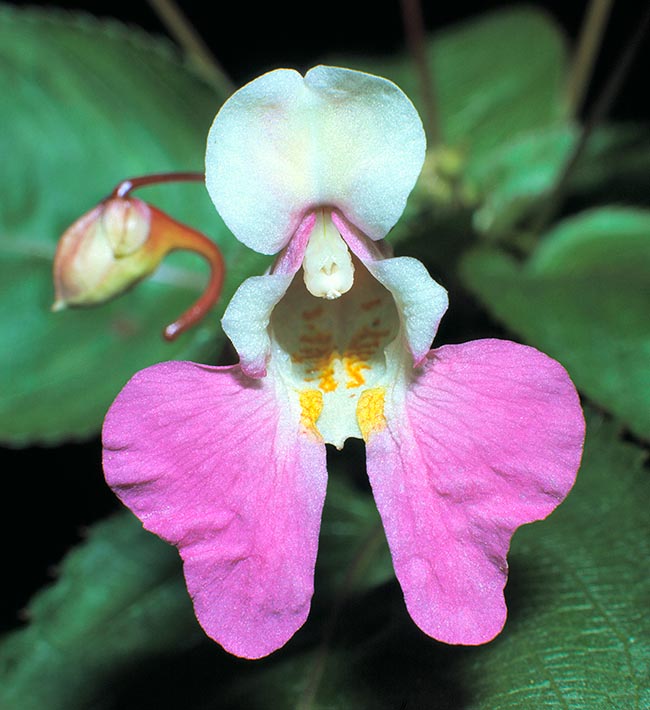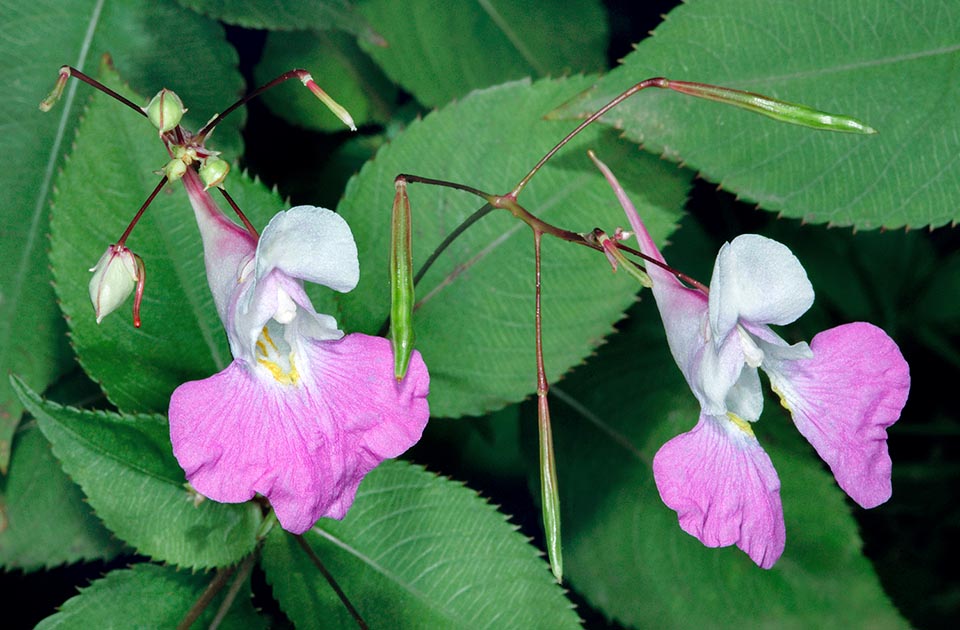Family : Balsaminaceae

Text © Prof. Pietro Pavone

English translation by Mario Beltramini

Native to Himalaya where it grows along rivers and in humid sites, Impatiens balfourii is an up to 120 cm tall herb © Giuseppe Mazza
Impatiens balfourii Hook.f. is a species native to Himalaya, in particular to Kashmir and surrounding areas. It grows along the banks of the rivers and in the humid locations up to 1800 m of altitude.
Common names: Balfour’s touch-me-not, Kashmir balsam.
Etymology: the Latin term Impatiens means “impatient” of “intolerant” and refers to the explosive dehiscence of the fruits bursting even if just touched. The specific epithet balfourii is in honouring the Scottish botanist Isaac Bayley Balfour (1853-1922), expert and lover of Himalayan plants.
Impatiens balfourii is an up to 120 cm tall herb. It has glabrous stem, reddish, very ramified with oval or lanceolate alternate leaves, toothed at the margin and carried by peduncles measuring about four centimetres.
The inflorescence is a raceme normally formed by 4 to 8 flowers.The 3-4 cm long flowers are hermaphrodite, tetracyclic and pentamerous (5 sepals, 5 petals, 5 stamens and 5 carpels.
The sepals have a petaloid look and are of white-purple colour, with a 1,2-1,8 cm long straight or just curved, nectariferous spur. The four lateral petals are concrescent at the base two by two, the lower ones have dark pink or violaceous stem, the upper petals are white or pale pink.
The mouth of the spur is yellow dotted. The stamens have fused anthers and cover the gynaeceum formed by five carpels grown together in a superior ovary with very reduced style and stigma.
The flowering period goes from July to September.
The pollination is done by insects, in the USA also by birds (hummingbirds). The fruits are about 2 cm capsules, explosive, that throw the seeds up to 6 metres of distance. The seeds are numerous, globose or ovoidal, with a diametre of about 2,5-3 mm, glossy, glabrous and don’t have albumen.

Introduced in Europe in 1901, despite its low tolerance to the frost, it has proven to be able to colonize open habitats intensely populated at the expense of the local biodiversity. Just bumped, the fruits throw seed even 6 m far. It is now often found in forest’s clearings and along country paths. Medicinal virtues © Giuseppe Mazza
The wild populations in Europe and in America got their origin from cultivated plants escaped from cultivation and are spreading thus modifying the physiognomy of the landscapes.
I. balfourii, introduced in Europe in 1901, in spite of its low tolerance to frost, has proven to be able to colonize open habitats even with high intensity of light and also close to water streams, reducing the biodiversity of the cenosis where it settles. It can be found also along the edges of the roads.
Specific studies have proven that this plant produces a remarkable quantity of phenols and of flavonoids that confer antimicrobial and antioxidant activities.
→ To appreciate the biodiversity within the BALSAMINACEAE family please click here.
